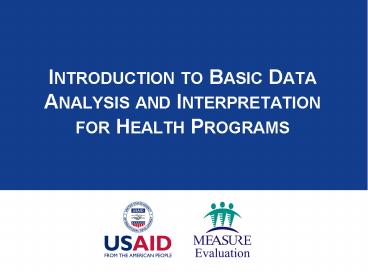Introduction to Basic Data Analysis and Interpretation for Health Programs - PowerPoint PPT Presentation
Title:
Introduction to Basic Data Analysis and Interpretation for Health Programs
Description:
INTRODUCTION TO BASIC DATA ANALYSIS AND INTERPRETATION FOR HEALTH PROGRAMS * * What is the purpose of monitoring and evaluation? M&E is an essential process in ... – PowerPoint PPT presentation
Number of Views:631
Avg rating:3.0/5.0
Title: Introduction to Basic Data Analysis and Interpretation for Health Programs
1
Introduction to Basic Data Analysis and
Interpretation for Health Programs
2
Training Objectives
- To improve understanding of statistical and
monitoring and evaluation (ME) concepts in data
analysis - To build skills in basic data analysis, including
setting targets and calculating program coverage,
and service utilization and retention - To enhance skills in data interpretation
3
Training Overview
- Training introduction
- Module 1 Data analysis key concepts
- Module 2 Basic analyses
- Module 3 Data presentation interpretation
- Review of key themes
4
Introductions
5
Training Introduction
6
Training Introduction Learning Objectives
- Understand the importance of improving
data-informed decision making - Understand the role of monitoring and evaluation
(ME) data in decision making - Understand the importance of data analysis and
interpretation
7
- without information, things are done
arbitrarily and one becomes unsure of whether a
policy or program will fail or succeed. If we
allow our policies to be guided by empirical
facts and data, there will be a noticeable change
in the impact of what we do. - National-level Policymaker, Nigeria
8
Why Improve Data-informed Decision Making?
- HIV epidemic
- Resurgence of TB
- Continued prevalence of malaria
- Pockets of stalled fertility decline
- Population burden
- Shortage of health care workers
9
Context
Pressing need to develop health policies,
strategies, and interventions
10
Monitoring and Evaluation
- Track changes in program performance over time
- Monitoring
- Attribute program outcomes to their causes
- Evaluation
11
Data
- Data sources
- Service delivery statistics
- Census
- Surveys, evaluations, research studies
- Sentinel surveillance
- Budget information
- Data vs. information
- unsynthesized vs. synthesized
12
Purposes of Monitoring and Evaluation
- Determine whether a plan or program is on
schedule with planned activities - Assess whether a policy, plan, or program has
produced desired impacts - Generate knowledge
- Identify programmatic gaps, factors that
influence health outcomes, etc. - Inform policy, planning, or program decisions
13
ME Is Not an Enemy
- Policymakers, program managers, and ME/strategic
information specialists can be partners - Strong decision making and management rely on
high-quality ME / strategic information - Data quality is linked to data use
14
Monitoring and Evaluation allows.
- data-based decisions,
- which lead to
- better health programs and
- better health outcomes
15
Group Participation
- Who analyzes and interprets data in your
organization?
16
We can use information to
- Inform policies and plans
- Raise additional resources
- Strengthen programs and improve results
- Ensure accountability and reporting
- Improve quality of services provided
- Contribute to global lessons learned
17
Making Data Speak in Thailand
- Need Strengthen commitment of policymakers to
HIV prevention - Data Behavioral and epidemiological data
- Response
- Analyzed data with Asian Epidemic Model and GOALS
model - Determined responses and resources needed
- Communicated data to stakeholders
- Decision/Action
- Successfully emphasized prevention agenda in
national strategic plan and developed an
operational plan to guide prevention programming
18
Using NNRIMS Data to Inform Resource Allocation
- Need Strengthen monitoring of HIV/AIDS service
delivery - Data HIV service delivery indicators
- Response
- Development of NNRIMS, a routine information
system - Quarterly reports summarizing data prepared for
and reviewed by LGA managers decision makers - Decision/Action
- Chairman procured 480 HIV test kits, enabling
more people to get tested in Doma
19
Key Messages
- Decisions based on evidence lead to better health
outcomes - We all have a role in ME partners in progress
- High-quality information is needed for decision
making at policy, planning, and program levels - Purpose of ME is not just to produce more
information but to inform action































